Tokyo Metropolitan Art Museum

The first retrospective exhibition of Tamana Araki, a New York-based artist who continues to engage in a wide range of expressive activities from prints to installations, will be held at the Tokyo Metropolitan Art Museum in Ueno, Tokyo. It is being held at The exhibition period is until October 9, 2023.


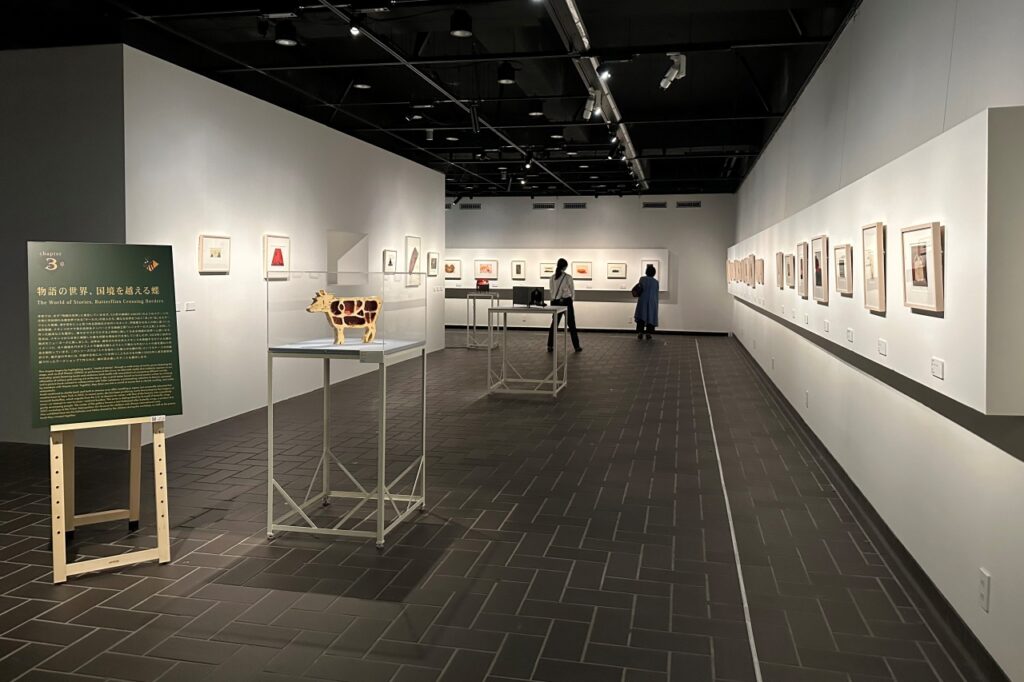
Tamana Araki (1970-) studied abroad in Mexico after graduating from Musashino Art University Junior College in 1991, and was fascinated by the unique culture where “brightness and darkness'' and “life and death'' coexist. Masu. Since then, he has repeatedly stayed in Mexico, creating works with a unique world view through a variety of expressions, including copperplate prints, which he learned techniques for locally, three-dimensional works, installations, and animations.
In 2012, she moved her base of activities to New York and took a new step by consciously living as an immigrant.In recent years, she has been interested in themes such as “crossing borders,'' “diversity,'' and “inclusion .''
This exhibition is Araki's first retrospective exhibition. Approximately 120 pieces of variety, from early works to new works, from palm-sized three-dimensional works to large-scale installations that take up an entire floor, “There of Memories'' (2023/to be shown for the first time at this exhibition), inspired by “ Ueno's memories.'' A rich collection of works is being developed.
The exhibition consists of four chapters. The charm of Araki's work is the motifs and expressions that evoke the lives and stories of people, giving a sense of intimacy and nostalgia, and at the same time creating a boundary between the everyday and the extraordinary that makes your heart feel transported somewhere. The viewer is invited on a mysterious journey through the world.
Chapter 1, "The 'Beginning, Beginning!' of Travel," introduces relatively early works, including those with travel motifs and those inspired by the experience of staying in Mexico. I am introducing this as a starting point.
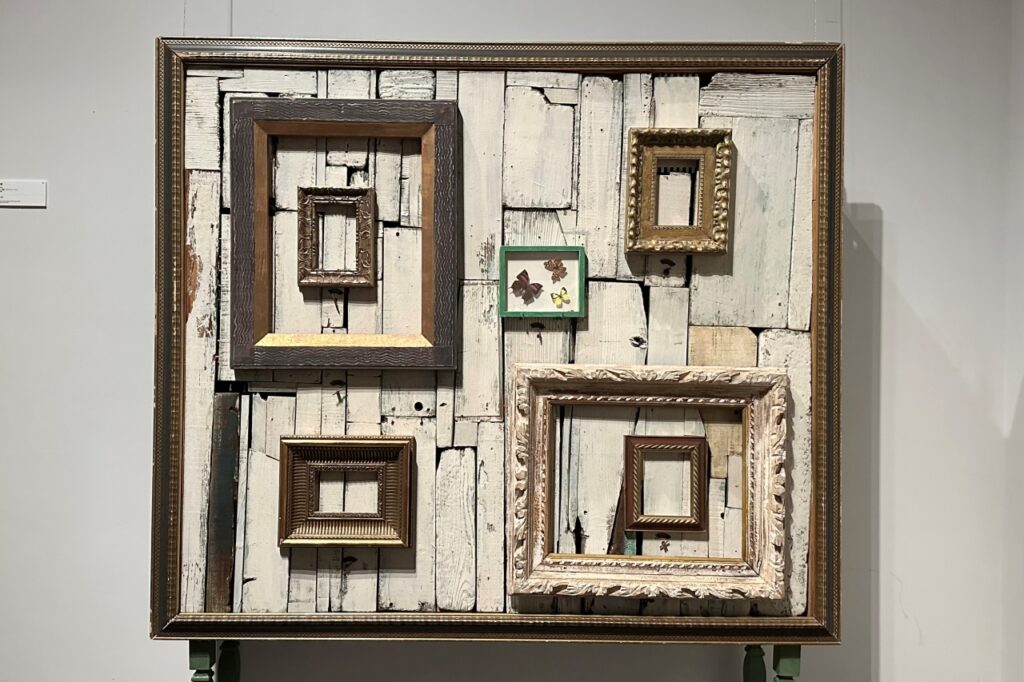
At the entrance, there is a piece called Untitled (1995) that is made up of a music box, and viewers can turn the screw themselves. Regarding this work, Araki commented in a gallery talk, “While one song is playing, I created it with the idea of going on an imaginary journey while listening to it.'' The many empty picture frames foreshadow wonderful encounters on the journey that are about to begin.
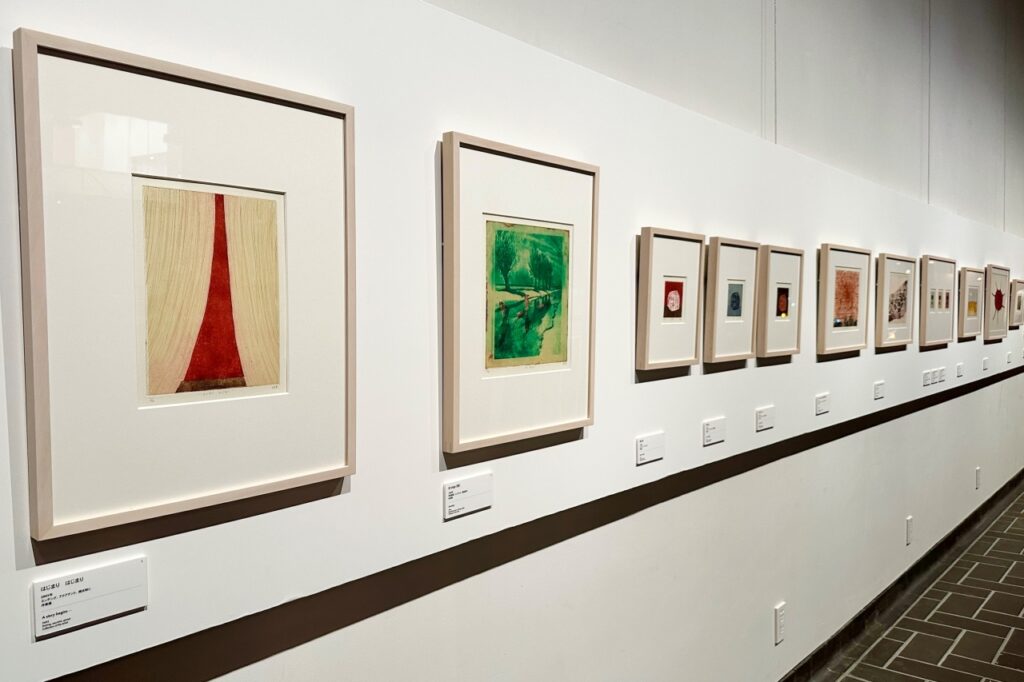
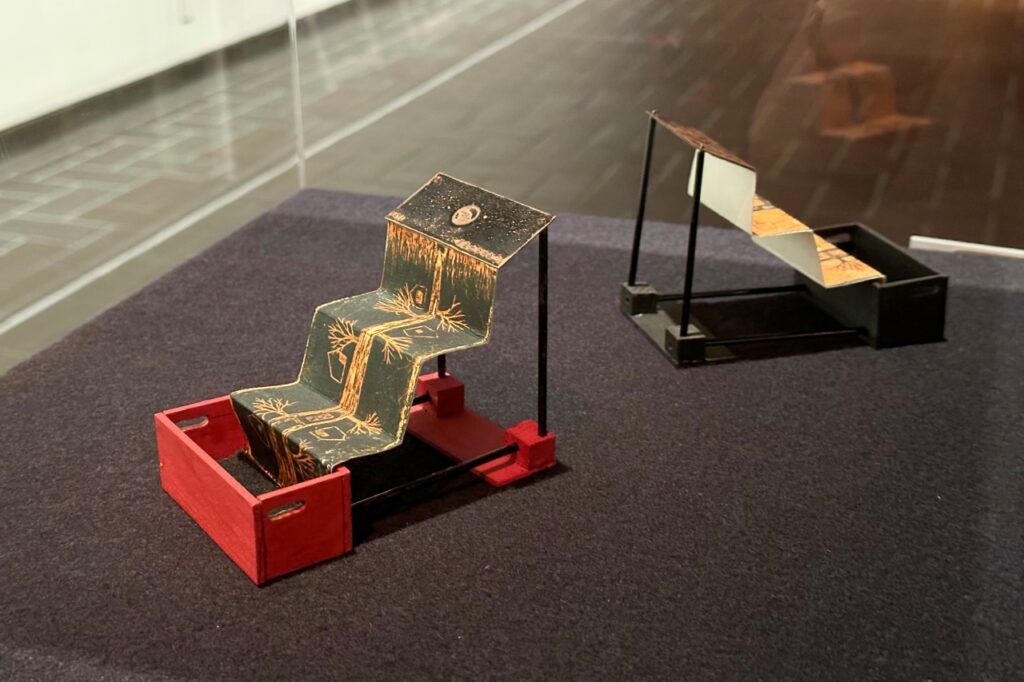
The exhibition begins like a curtain opening in “Beginning, Beginning'' (2003), and a story begins. “Day'' and “Night'' (1999) were made with the idea that “It would be great if there was a portable work that could be placed next to the bed in the room I stayed in while traveling, or on a small table by the train window.'' A unique foldable three-dimensional work created by. All are made using the copperplate engraving technique.
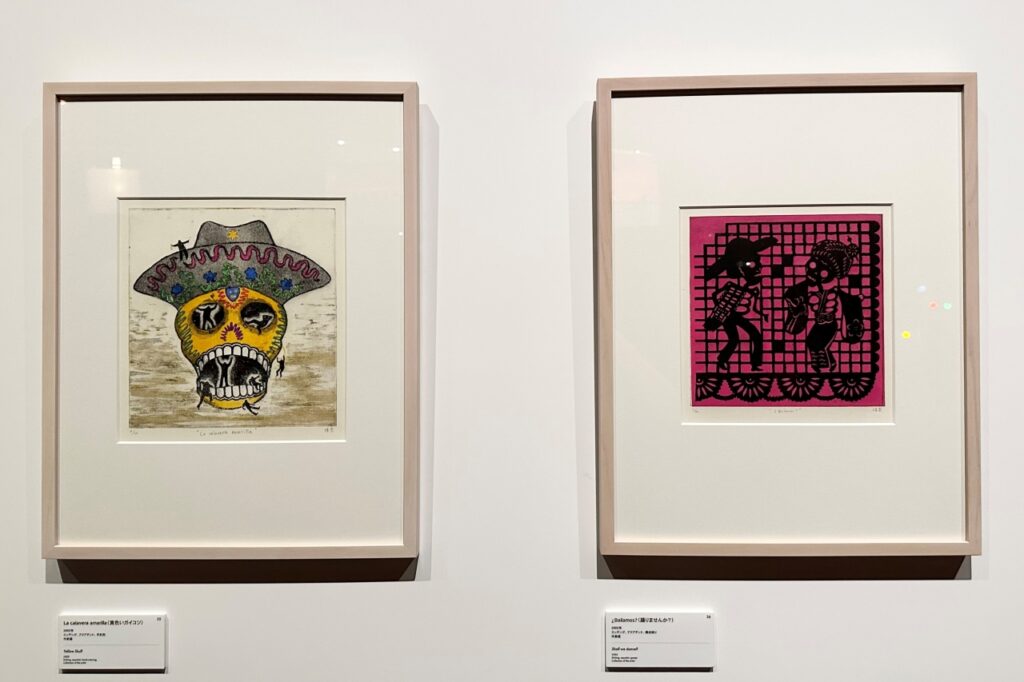
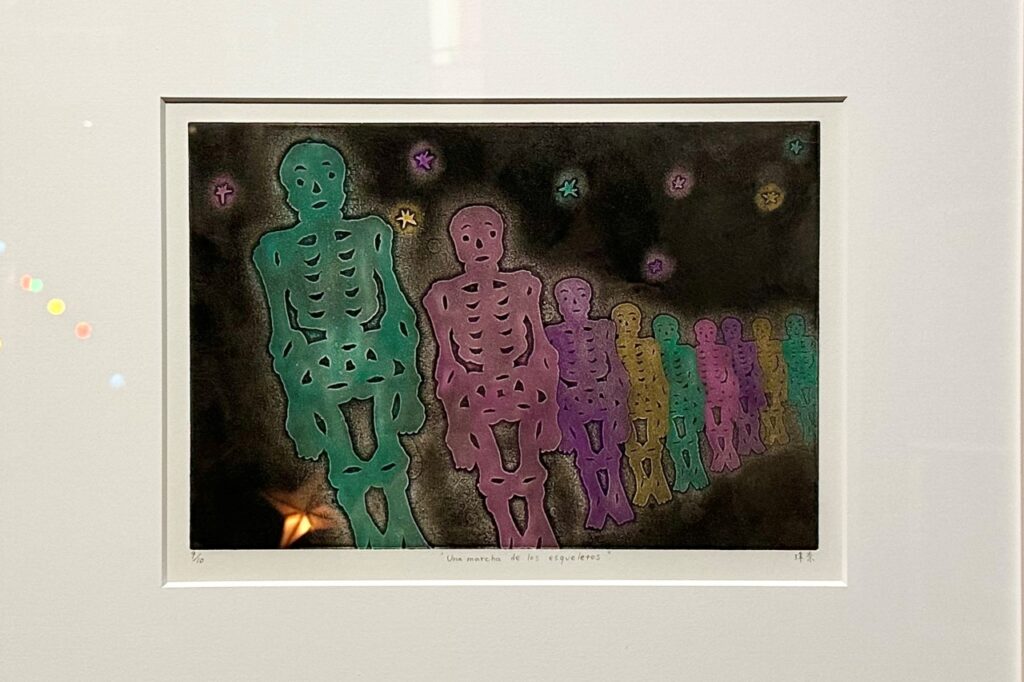
La calavera amarilla (Yellow Skeleton) (2005), which uses skeletons as a motif, and Una marcha de los esqueletos (March of the Skeletons) (2004), which use colorful decorations and illuminations to welcome the dead cheerfully, You can feel the influence of Mexico's unique view of life and death, as exemplified by the “Sun''.
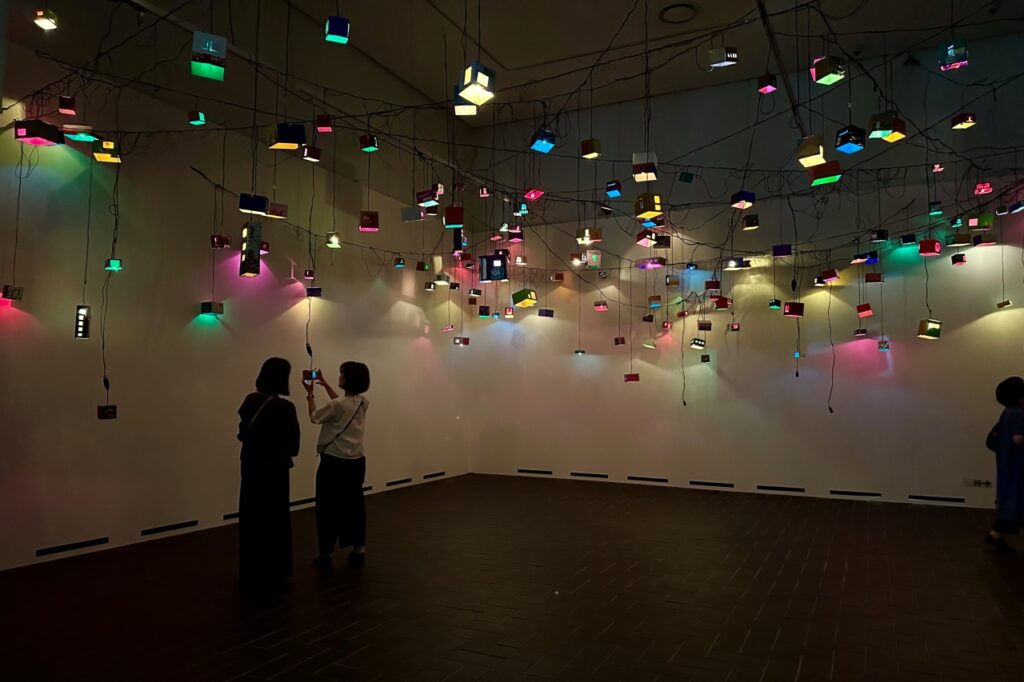
“Caos poetico” (2005) is a fantastical scene sprinkled with warm light reminiscent of a lantern. This design was inspired by the strong lifestyle of poor people in Mexico, who used to draw electric wires from telephone poles without permission and use them to light their houses and food stalls, and how the streets decorated with these lights were so beautiful that they looked like a starry sky. This is an installation that was inspired by the concept.
Numerous power cords hang from the ceiling, and at the end of them are attached small boxes that look like houses. Not only the color of the light but also the pattern of each small box is different, and various items are used, such as a box of tea that Araki drank in Mexico, a bus ticket, and a flyer for Lucha Libre (Mexican wrestling).
The image of the chaotic state comes from the “strength of living in chaos'' that Araki felt from the houses painted with colorful paint and the people of Mexico City living there. Is not it.
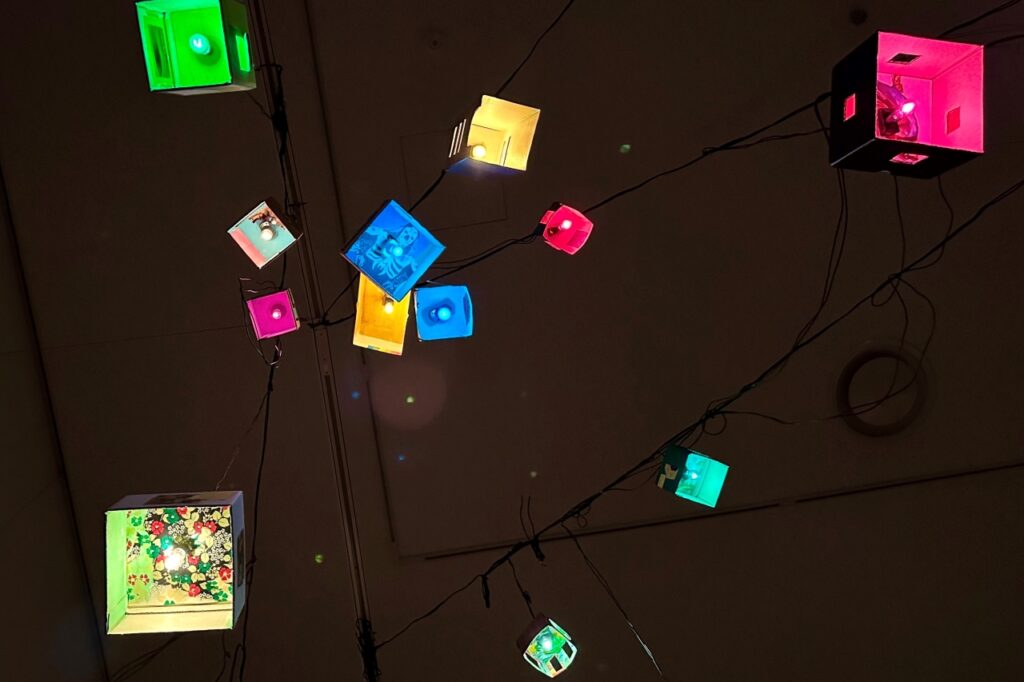
Please note that this work is a participatory work. Following the guidance of the exhibition facilitators (volunteers who support the viewing, nicknamed Kee-jin), viewers were able to connect small boxes to any socket of their choice and make them part of the cityscape.
In Chapter 2, “Darkness Lurking in Soft Light,” two installations are arranged symmetrically to express light and darkness, respectively.

In Uchi (1999), which Araki created with the image of the housing complex where he lived as a child, about 100 boxes made of white plywood were set up against a white wall to resemble the houses in the housing complex. thing.
Each box is randomly numbered, and viewers receive a key from the facilitator and open the door of the box that matches the number. Then, light spilled out from inside, and we began to see the warm lives of each family depicted in the prints, which was hard to imagine from the uniform exterior.
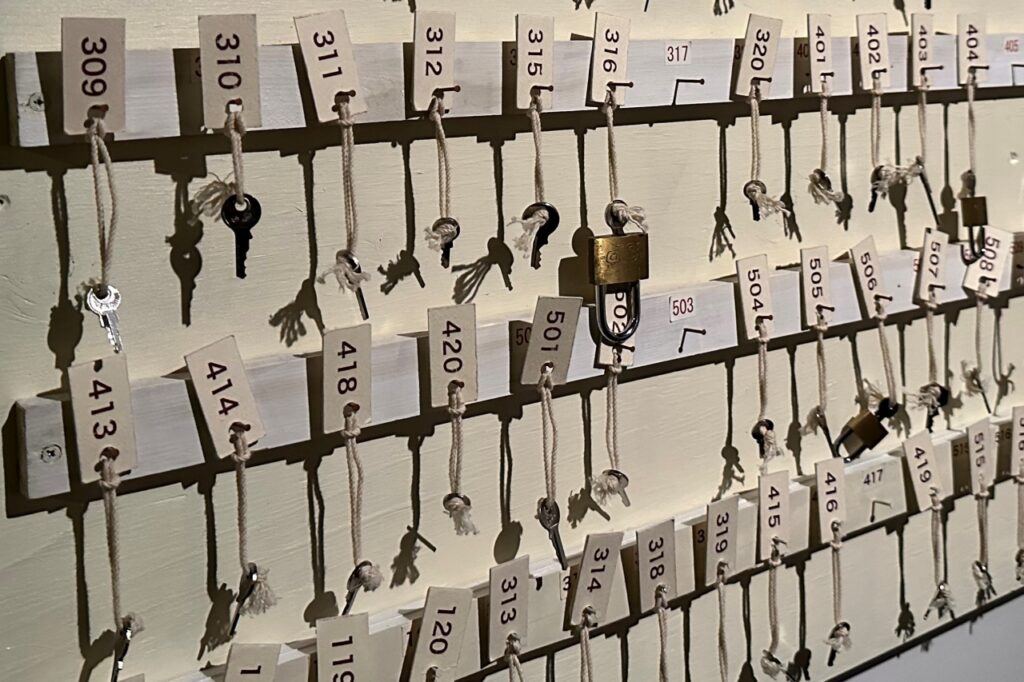

On the other side of the wall of “Home'', “Invisible'' (2011) has a strong presence as a black and ominous object spreads out from above, as if filling out the everyday world of small happiness in the same work. .

This work was created after the Great East Japan Earthquake in 2011, and visually captures the feelings of anxiety and disgust felt at the time due to the nuclear power plant accident, in which invisible dangerous substances called radioactive materials might come flying. What I tried to make. The black objects are said to have been made by dyeing black orchid fibers purchased in large quantities in Mexico, rolling them into dumplings, and pasting them together.
Chapter 3, “The world of stories, butterflies that cross borders,'' fully introduces Araki's “world of stories,'' which is cute yet somehow unsettling, and full of the poetic nature of Araki.
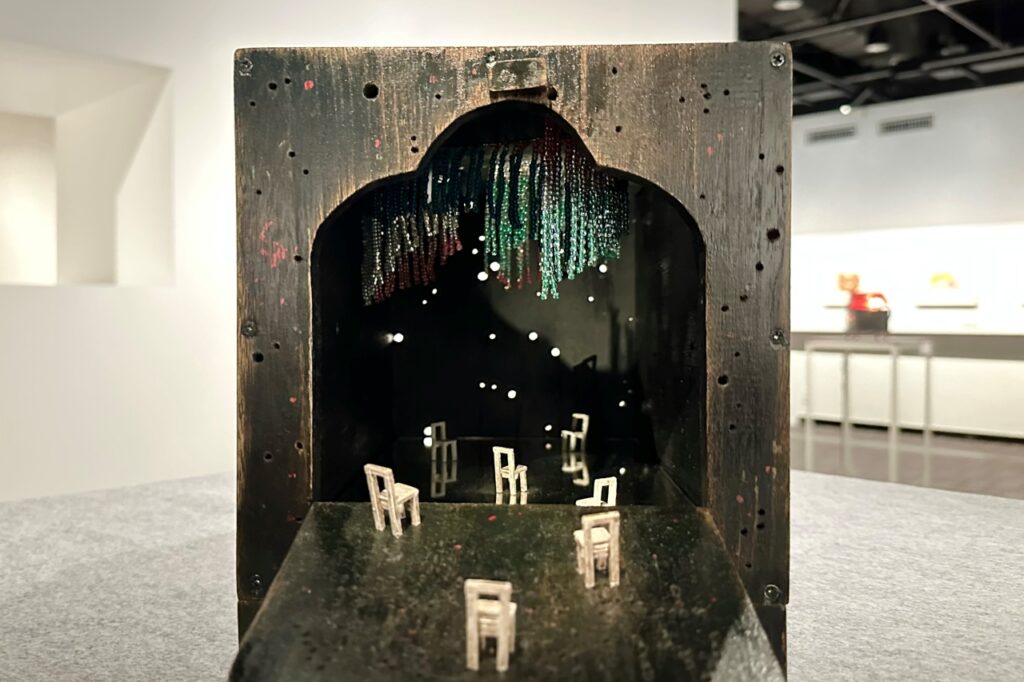
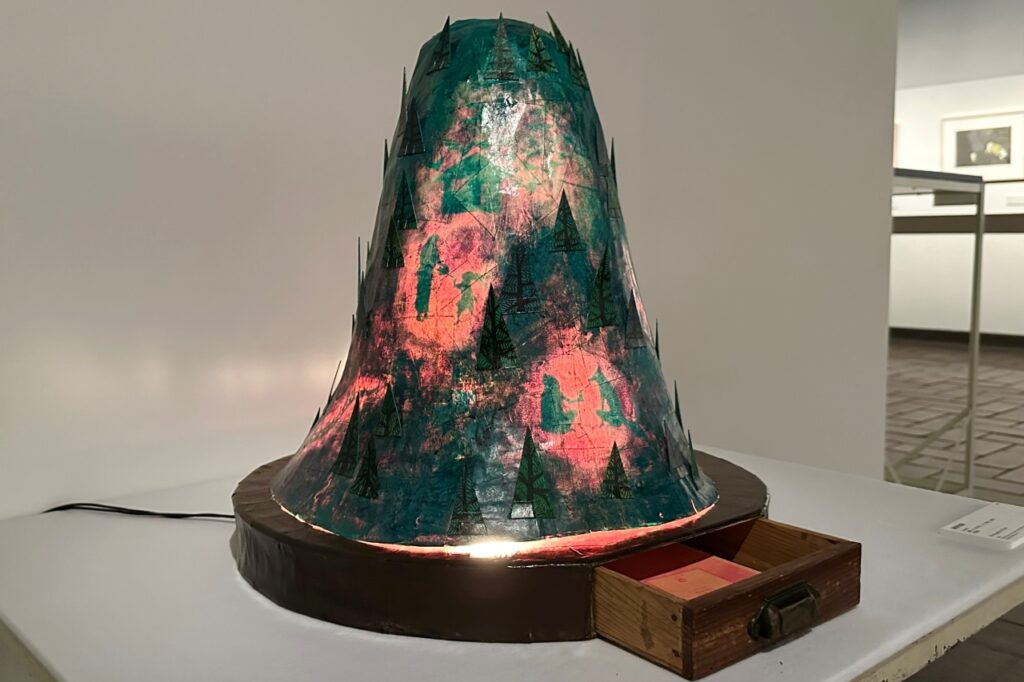

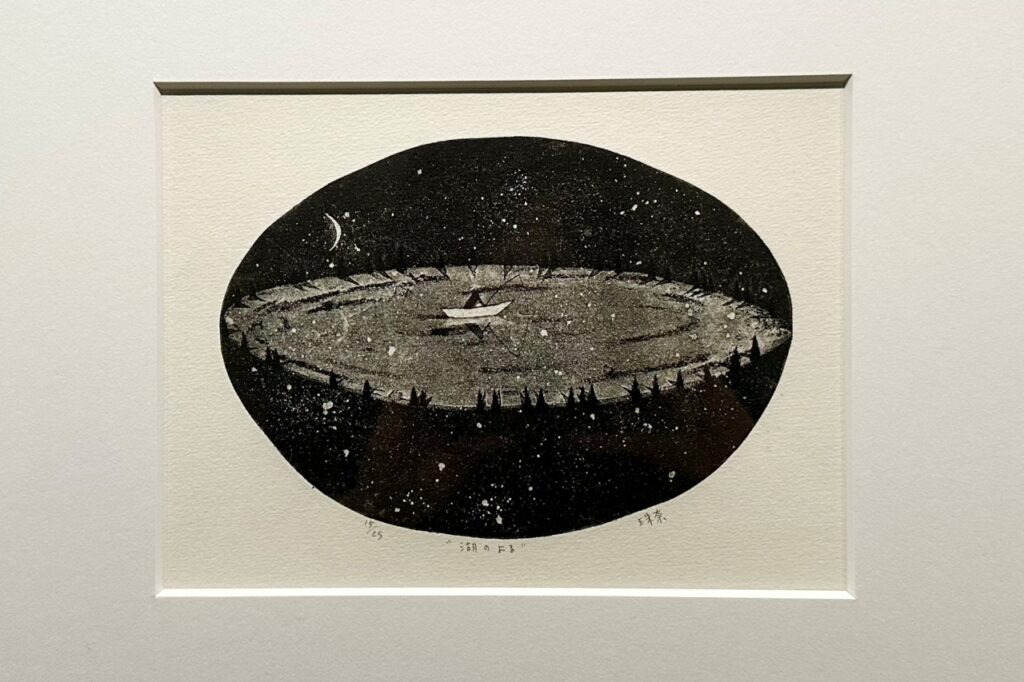
Most of the people Araki draws are just silhouettes, and their expressions cannot be seen. He is alone in the vast world, sometimes facing something frightening. Do you see loneliness, freedom, or a longing for something? As my own self mysteriously overlapped with my own, my memories were shaken, and before I knew it, my mind seemed to be absorbed into the world of the work.
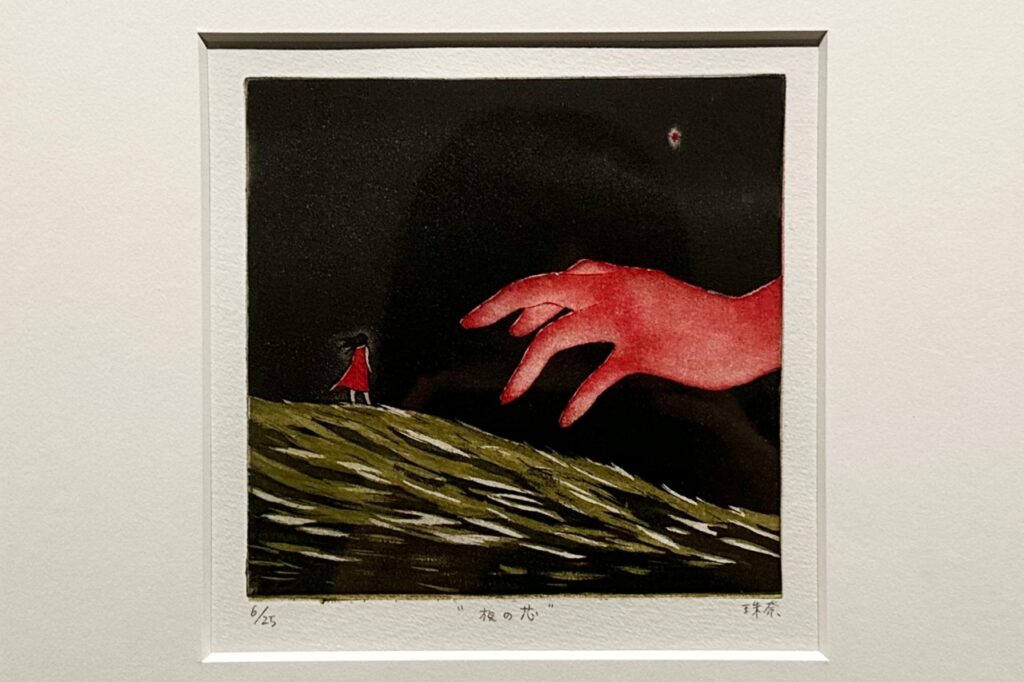

NeNe Sol – The Youngest Sun – is a picture book based on the Mayan myth of the creation of the sun that is still passed down in the Chiabas region of Mexico, and was co-produced by Mr. Araki and Leñateros Kobo, a printmaking studio whose members are mainly indigenous Mayan people. thing. A prototype version and the original illustrations are on display at the venue. The unique binding, which looks like a stone carving, was created by a Mexican sculptor.

In 2022, Araki will hold a workshop called “I Hear Folk Tales'' at the Tokyo Metropolitan Art Museum with children who have roots in various countries. The children experienced making tents and picture books in the shape of butterflies using paper pulp, and they also introduced folk tales from the countries where they have roots. The tent that was actually made at that time is on display at the venue.
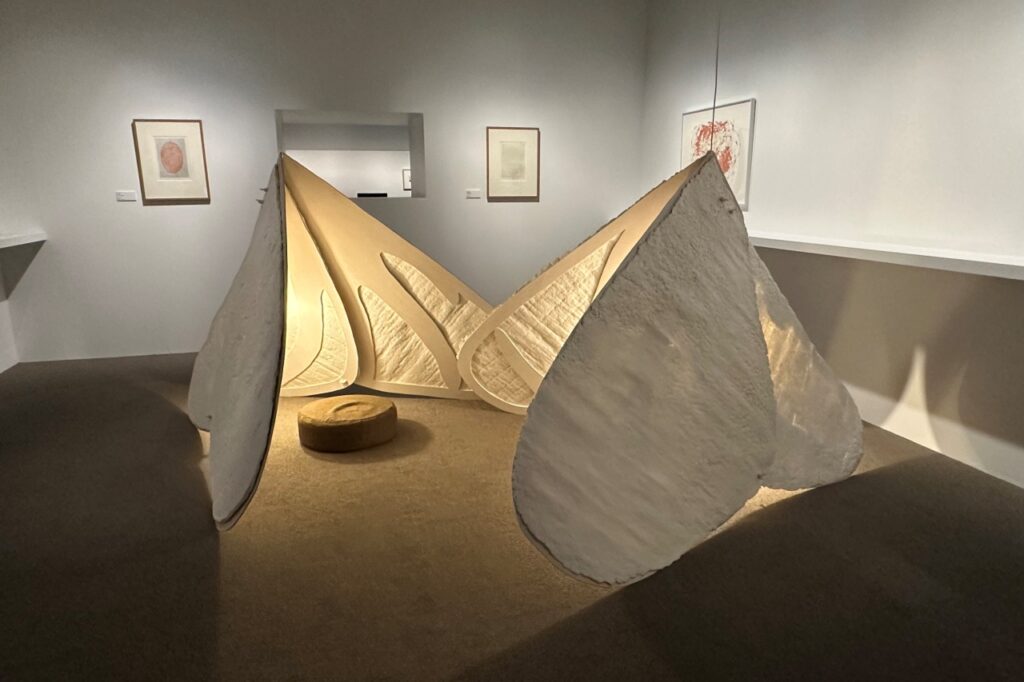
Mr. Araki is interested in the Monarch butterfly that he encountered in Mexico, which migrates from country to country like a migratory bird to overwinter. This work was apparently inspired by the image of a Monarch butterfly resting its wings on the ground.
This work is based on Araki, who lived in the United States as an immigrant during the Trump administration, and his thoughts on refugees who are blocked by walls and unable to cross borders, and the monarch butterfly, which can move freely around the world regardless of borders. It is superimposed on.
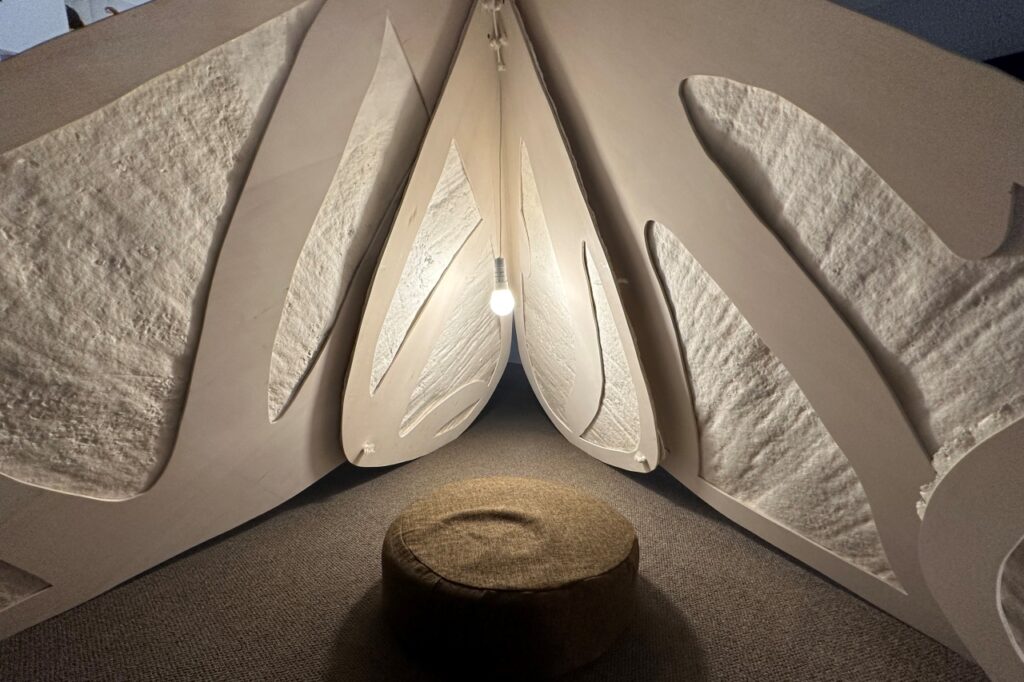
Additionally, since tents are meant for people to temporarily stay or take shelter, Araki revealed that this work has the meaning of “a place where people can hide with peace of mind.''
In Chapter 4, “An Adventure Around the Bottom of Ueno,'' we use the entire space of the exhibition room on the third basement floor, which can be called “there'' ( the bottom) of the museum, with a ceiling height of 10 meters, to create ideas for “Memories of Ueno.'' The large-scale installation I obtained , “Beyond Memories'' (2023), will be the last part of this exhibition's journey.

During my research, I learned that it became the stage for many historical events, such as the birth of Japan's first parks, museums, and zoos, the Great Kanto Earthquake, the Great Tokyo Air Raid, and the emergence of the black market after the war, and attracted people from various countries and regions. Mr. Araki was attracted to the chaos of Ueno, a place he had adopted.
Around the huge object resembling a black birdcage in the center, fragmentary images of Ueno's past and present are shown, including photographs of Ueno taken by Araki himself and ukiyo-e prints depicting Ueno. , a pair of mirrors symbolizing “eyes'' suspended from the ceiling play the role of bringing to light the image of Ueno that was buried “down there'' (at the bottom).

The object is “a cage-like, hollow basket that swallows up and spits out the past, the future, the beautiful, and the trivial.''The upper part of the object looks like it's being grasped by a large hand. Some of the columns are curved, as if they were forced out from within or pried open from the outside.
Regarding this shape, Araki says, “Bird cages and cages seem to protect the birds, but they also confine them so that they can't fly away freely, and the shape emerges from these dual aspects.'' ” he explained.
Regarding this exhibition, Mr. Araki says, “I would like many children and young people to see it.I hope that they can go underground and have a somewhat mysterious experience, and enjoy it as if they were traveling.'' The journey from the ground to "there" in Ueno also aroused my longing for another journey.
An exhibition that brings to mind the common themes that modern society has across countries and regions, such as crossing borders, diversity, and inclusion, which Araki is interested in. ' will be held until October 9, 2023.
Ueno's "Beginning, Beginning" Tamana Araki Exhibition
| Period | July 22, 2023 (Sat) – October 9, 2023 (Monday/holiday) |
| venue | Tokyo Metropolitan Art Museum Gallery A, B, C |
| Opening hours | 9:30-17:30, Fridays 9:30-20:00 (Last entry is 30 minutes before closing) |
| Closed days | Monday, September 19th (Tuesday) *However, the office will be open on September 18th (Monday/Holiday) and October 9th (Monday/Holiday) |
| Admission fee | General: 1,100 yen / University and vocational school students: 700 yen / Ages 65 and over: 800 yen *Free for high school students and under *Please check the official website for other details on admission fees. |
| Sponsored by | Tokyo Metropolitan Foundation for History and Culture Tokyo Metropolitan Art Museum |
| inquiry | 03-3823-6921 (Tokyo Metropolitan Art Museum) |
| Exhibition official website | https://www.tobikan.jp/hajimarihajimari |
*The contents of the article are as of the time of reporting. Please check the official website for the latest information.
Article provided by: Kokosil Ueno


